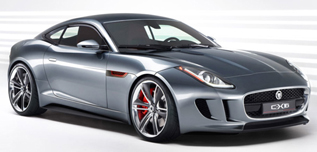Jaguar roars back into sports cars
 Jaguar’s F-type 2-seater springs from the C-X16 concept car (above) it showed last September.
Jaguar’s F-type 2-seater springs from the C-X16 concept car (above) it showed last September.The cat is back, this time with energy efficiency in its sights.
Indian-owned, British car maker Jaguar said it will return to its iconic sports car business with a new “F-type” convertible 2-seater that succeeds the iconic “E” model that went out of production in 1976.
The new car is based on the C-X16 concept car that Jaguar unveiled in September at the Frankfurt Auto Show, and marks a return to a market that “we have been absent from for too long,” said Jaguar global brand manager Adrian Hallmark at the New York Auto Show (I guess you have to have a name like “Hallmark” to get a job like that).
Jaguar released a video (below) of the car racing around a track, heralded by former Formula 1 driver and Daytona and Le Mans champion Martin Brundle.
What’s not entirely clear is why Jaguar is now hailing the F-type as a return to the sports car market, when a year ago it announced it would build a plug-in hybrid electric/gasoline-powered sports car, the C-X75 (Jaguar wasn’t immediately available for comment). The reason probably relates to the public’s hesitance to buy electric cars and to instead purchase more efficient conventionally fueled vehicles.
Unlike the C-X75, the F-type does not have plug-in electric capability. Jaguar is giving the gasoline-powered car an aluminum chassis, lightening its weight and contributing to fuel efficiency.
“The car could be considered a spiritual successor the convertible Jaguar E-type, which was produced between 1961 and 1975,” said Autoweek. “The E-type is considered by many to be one of the most beautiful cars ever produced.”
According to the BBC, Jaguar said last September that the C-X16 concept - now the F-type - accelerates from zero to 62 mph in 4.4 seconds and emits 165 grams of CO2 per kilometer, comparatively low for that sort of car - but environmentally worse than the hybrid C-X75, rated at 99g/km.
The concept car included a regenerative braking system that charged lithium ion batteries by converting braking energy using the Kinetic Energy Recovery System developed for the Formula 1 racing circuit, the BBC said. Presumably the F-type includes the same.
Jaguar, owned by India’s Tata Motors, will build the car in Birmingham, England, for sale in 2013.
You can return to the main Market News page, or press the Back button on your browser.

